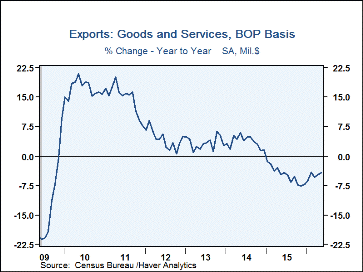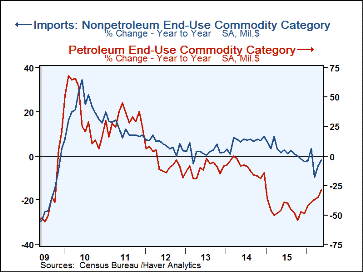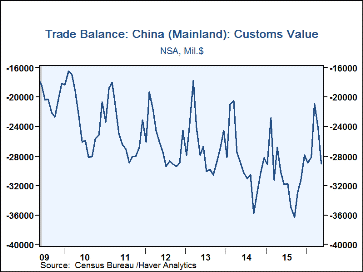 Global| Jul 06 2016
Global| Jul 06 2016U.S. Trade Deficit Deepens as Exports Ease and Imports Jump
by:Tom Moeller
|in:Economy in Brief
Summary
The U.S. trade deficit in goods and services widened to $41.1 billion in May from an unrevised $37.4 billion in April. The Action Economics Forecast Survey had expected a $40.0 billion deficit. The latest figure was the deepest in [...]
The U.S. trade deficit in goods and services widened to $41.1 billion in May from an unrevised $37.4 billion in April. The Action Economics Forecast Survey had expected a $40.0 billion deficit. The latest figure was the deepest in three months and occurred as exports eased 0.2% (-4.2% y/y) following a 1.4% rise, and imports increased 1.6% (-3.1% y/y) after a 2.0% jump.
The decline in exports reflected a 0.3% dip (-6.2% y/y) in goods exports. It was led by a 2.7% drop (-1.0% y/y) in auto & parts exports and a 1.9% decline (-4.5% y/y) in capital goods exports. Nonauto consumer goods exports followed with a 1.7% shortfall (-2.6% y/y). Exports of industrial supplies & materials improved 0.1% (-13.4% y/y) and foods, feeds & beverage exports gained 5.5% (-6.8% y/y). Exports of services eased 0.1% (-0.3% y/y) led by a 1.1% decline (+1.7% y/y) in travel exports and a 0.4% drop (-4.8% y/y) in charges for the use of intellectual property.
Imports of goods increased 1.9% (-4.1% y/y) as industrial supplies & materials imports surged 6.9% (-12.0% y/y). The value of energy-related petroleum product imports led the increase and jumped 11.2% (-28.3% y/y) as the per barrel cost of crude oil surged to $34.2. The quantity of energy-related product imports declined, however, by 2.5% (+7.4% y/y). Nonauto consumer goods imports jumped 2.7% (-2.0% y/y) while auto imports gained 0.9% (-1.1% y/y). Imports of foods, feed & beverages rose 0.7% (2.8% y/y, but capital goods imports declined 1.7% (-3.8% y/y). Services imports were unchanged ( 2.1% y/y). Travel imports also were unchanged (8.4% y/y) and charges for the use of intellectual property eased 0.3% (+0.3% y/y).
By country, the trade deficit with mainland China deepened to $29.0 billion. Exports declined 1.7% (-2.8% y/y) while imports rose 13.8% (-3.9% y/y). Exports to Japan increased 11.5% (-3.7% y/y) but imports declined 9.3% (-7.2% y/y). The trade deficit with the European Union increased to $13.4 billion. Exports fell 4.2% (-5.0% y/y) and imports gained 1.6% (-2.0% y/y).
The international trade data can be found in Haver's USECON database. Detailed figures are available in the USINT database. The expectations figures are from the Action Economics Forecast Survey, which is carried in the AS1REPNA.
The minutes to the latest FOMC meeting can be found here.
| Foreign Trade in Goods & Services (Current Dollars) | May | Apr | Mar | Y/Y | 2015 | 2014 | 2013 |
|---|---|---|---|---|---|---|---|
| U.S. Trade Deficit | $41.1 bil. | $37.4 bil. | $35.5 bil. | $40.2 bil. (5/15) |
$500.4 bil. | $490.2 bil. | $461.9 bil. |
| Exports of Goods & Services (% Chg) | -0.2 | 1.4 | -1.1 | -4.2 | -4.9 | 3.6 | 3.4 |
| Imports of Goods & Services (% Chg) | 1.6 | 2.0 | -4.6 | -3.1 | -3.7 | 4.0 | 0.0 |
| Petroleum (% Chg) | 8.4 | 5.0 | -3.9 | -28.7 | -45.5 | -9.6 | -11.0 |
| Nonpetroleum (% Chg) | 1.5 | 2.2 | -5.7 | -1.9 | 2.2 | 6.5 | 2.0 |
Tom Moeller
AuthorMore in Author Profile »Prior to joining Haver Analytics in 2000, Mr. Moeller worked as the Economist at Chancellor Capital Management from 1985 to 1999. There, he developed comprehensive economic forecasts and interpreted economic data for equity and fixed income portfolio managers. Also at Chancellor, Mr. Moeller worked as an equity analyst and was responsible for researching and rating companies in the economically sensitive automobile and housing industries for investment in Chancellor’s equity portfolio. Prior to joining Chancellor, Mr. Moeller was an Economist at Citibank from 1979 to 1984. He also analyzed pricing behavior in the metals industry for the Council on Wage and Price Stability in Washington, D.C. In 1999, Mr. Moeller received the award for most accurate forecast from the Forecasters' Club of New York. From 1990 to 1992 he was President of the New York Association for Business Economists. Mr. Moeller earned an M.B.A. in Finance from Fordham University, where he graduated in 1987. He holds a Bachelor of Arts in Economics from George Washington University.










